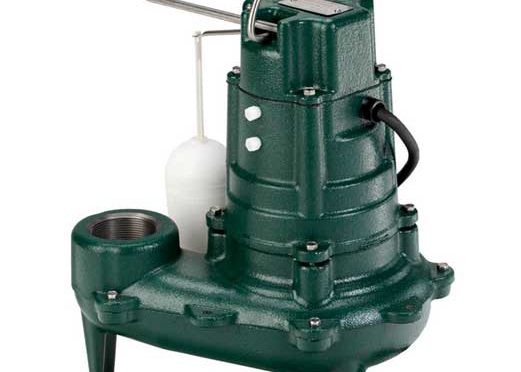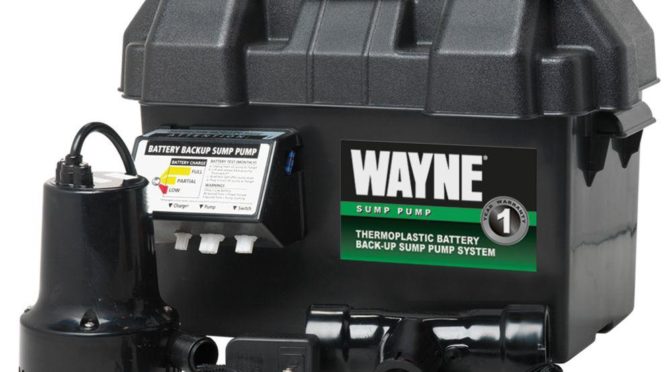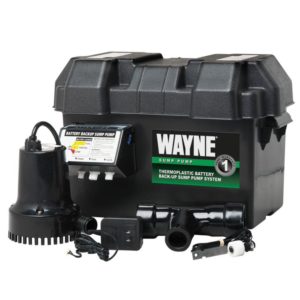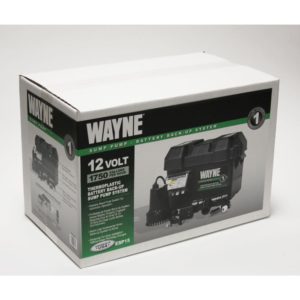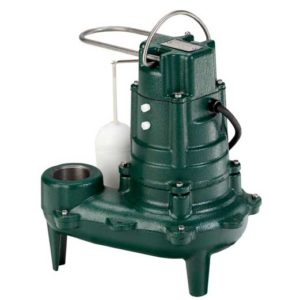 When it comes to choosing a reliable, buy-it-for-life type sewage or sump pump, one of our primary recommendations is to choose a model primarily, if not fully, based on a cast iron housing. In fact, we prefer a full cast iron pump housing, switch case, and base if possible. Thermoplastic is cheaper to source and easier to shape, which is why you’ll see it all over budget sump pumps (e.g., the Wayne CDU980E). But if you want a sump pump that you can throw in a sump pit and forget about for the next 10 years or more, you don’t want plastic; you want iron. On top of that, there are a special class of submersible pumps that do everything sump pumps can do and more; they just aren’t marketed as sump pumps.
When it comes to choosing a reliable, buy-it-for-life type sewage or sump pump, one of our primary recommendations is to choose a model primarily, if not fully, based on a cast iron housing. In fact, we prefer a full cast iron pump housing, switch case, and base if possible. Thermoplastic is cheaper to source and easier to shape, which is why you’ll see it all over budget sump pumps (e.g., the Wayne CDU980E). But if you want a sump pump that you can throw in a sump pit and forget about for the next 10 years or more, you don’t want plastic; you want iron. On top of that, there are a special class of submersible pumps that do everything sump pumps can do and more; they just aren’t marketed as sump pumps.
One of the best kept sump pump secrets involves choosing sewage, effluent, and dewatering pumps for high-end sump pump service instead of regular sump pumps. The reason behind this is simple: a sewage pump is designed to handle much rougher conditions (i.e., solid wastes) than a regular sump pump, while the reverse isn’t true. In particular, sewage pumps capable of grinding solids are pretty much guaranteed to keep your sump pump working through any debris or naturally-occurring contaminants in your groundwater. Today we’re going to take a look at one of the best sump pumps (if not the best) under $400: the Zoeller M267 Waste-Mate Sewage Pump, 1/2 Horsepower, 115V. If you’re wondering whether it’s worth the money, it absolutely is, and you can buy it here.
Key Features of the Zoeller M267 Sewage Pump (60 Second Summary)
The Zoeller M267 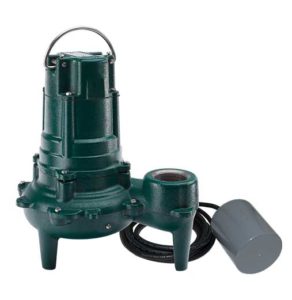 sewage pump is a submersible pump with a 1/2 horsepower motor, a 7,680 gallon per hour maximum water flow rate, and a 3 year warranty that begins with the date of manufacture. It’s 16 inches tall, 13.7 inches wide, and 10.8 inches deep with a maximum pumping height of 21.5 feet and a switch-on/switch-off height of 4 inches and 12 inches respectively. The aforementioned pump switch is vertical. It draws between 1.5 and 10.4 amps and runs on 115-460 volts. It doesn’t come with a battery backup, it weighs 35.8 pounds on our scale, and has a 10-foot long power cord. The working temperature spans 40-130 degrees Fahrenheit, it’s self-priming and housed in cast iron and stainless steel, and the discharge size is 2″ female or 3″ male NPT. It’s designed to be used with sump pits (sump basins) at least 15 inches in diameter.
sewage pump is a submersible pump with a 1/2 horsepower motor, a 7,680 gallon per hour maximum water flow rate, and a 3 year warranty that begins with the date of manufacture. It’s 16 inches tall, 13.7 inches wide, and 10.8 inches deep with a maximum pumping height of 21.5 feet and a switch-on/switch-off height of 4 inches and 12 inches respectively. The aforementioned pump switch is vertical. It draws between 1.5 and 10.4 amps and runs on 115-460 volts. It doesn’t come with a battery backup, it weighs 35.8 pounds on our scale, and has a 10-foot long power cord. The working temperature spans 40-130 degrees Fahrenheit, it’s self-priming and housed in cast iron and stainless steel, and the discharge size is 2″ female or 3″ male NPT. It’s designed to be used with sump pits (sump basins) at least 15 inches in diameter.
How Does the Zoeller M267 Compare to the Wayne CDU980E Sump Pump?
Compared to the Wayne CDU980E, the Zoeller M267 is a huge step forward. The CDU980E is a good pump for its price range, but the construction on the M267 is far superior, both in terms of the materials used and in the integrity of the connections. We’d estimate the typical M267 to have a 10-20 year lifespan, while we’d expect 5-7 years from the typical CDU980E. The maximum water pumping rate is close to 2x as fast in the M267 as that in the CDU980E, and it’s capable of grinding up to 2″ solids, which puts it in a different universe compared to the CDU980E in terms of its ability to resist slowdown or stoppage from debris in the sump pit. To put it simply, the CDU980E is a good budget pump, while the M267 might be the last sump pump you buy for your house.
Our Short and Long Term Experiences Installing and Using the Zoeller M267 Sewage Pump
You shouldn’t expect much trouble installing the Zoeller M267 as a sump pump; you basically connect it to your discharge pipe, plug it in, and lower it into the pit. From that point on, you might as well forget you’ve got a sump pump, because you’re virtually never going to need to look after it. The included instructions are thorough and written in clear English; even if you have limited plumbing experience, you should be able to follow them with a little help from a more experienced friend.
In terms of noise levels, it’s not the quietest sump pump on the market, but it runs so quickly that you barely have time to hear it. We found it significantly quieter than the Liberty pumps we frequently recommend replacing with the M267.
Regarding longevity, we can only give it the highest praise. We’ve never seen anyone replace an M267 after installing it. We believe the quality of the construction of these pumps has everything to do with their longevity. The oldest Waste-Mate we’re aware of has been running in a friend’s house for 24 years. It’s still running. We know several others that have lasted past 20 years with no signs of stopping.
Above all, we were impressed by the engineering and thoughtful design that went into the creation of the M267. It’s heavy, solid, and has the feel of a sump pump that’s not going to need its warranty. We liked the copious use of cast iron and stainless steel; we absolutely loved the fact that it was capable of grinding solids as a fail-safe for taking care of anything imaginable entering your sump pit (or up to 2″ spherical solids if you use it as a sewage pump).
Troubleshooting and Installation Tips to Get Your Zoeller M267 Working Sooner
There are very few things to keep in mind with the Zoeller M267 to ensure a long life. One that comes to mind is the junction body; you want to make sure that isn’t submerged in the sump, or that will allow water to get into the pump via the inside of the cord; once that happens, it’s no longer watertight, and you’ll destroy both the motor and the switches.
Check the float switch action every now and then, especially if you don’t have much water in your sump pit very often. Over time the float switch can become dry and sticky and become harder to move on its own. If this occurs, it might not activate when there’s actually water.
Make sure you run a discharge line at least 2″ in diameter; this pump is designed to move a lot of water, and a 1.5″ line won’t cut it. Don’t be afraid to run a 3″ line if necessary; that’s also within specifications.
When you buy a check valve for the M267, we’d recommend spending a few dollars more on a silent check valve. Even though the M267 is a quiet pump for how powerful it is, if you use a traditional hammer check valve, you’re still going to hear a “thunk!” every now and then when it kicks off. Buying a silent check valve like the Brady check valve will get rid of that sound for good. Similarly, we’d also recommend a separate water alarm; something cheap like the Basement Watchdog will give you an audible warning if water levels rise above the M267’s float switch. However, a better redundant solution for any AC sump pump than a simple water alarm is a full on backup pump.
As great as the M267 is, we always recommend buying a DC backup pump (or a water-based backup pump) to support it, or any AC-based sump pump. You’ll realize why the first time you have a power outage during a rainstorm. Before then, we suggest the Wayne WSM3300 if you’re looking for the best DC-based backup pump money can buy; it’ll test itself frequently for functionality and it’ll literally call you whenever it needs to activate during a power outage. If you’re on a smaller budget,the Wayne ESP25 is a good basic alternative. What’s important is that you have some system to keep your sump pit from overflowing if a storm takes out your electricity.
Zoeller M267 Sewage Pump Pros, Cons, and Value Comparison
Whether you’re buying the M267 as a sewage pump or as a sump pump, you won’t be disappointed. The fact that we know several owners who’ve put 20+ years of continuous service on these pumps speaks volumes. If you don’t want to find yourself either back in your sump pit (or worse, knee-deep in sewage) in a month or a year or 5 because your budget bargain box store pump stopped working, we’d strongly recommend just buying this pump and calling it a day. We’ve seen it installed in finished basements worth hundreds of thousands of dollars (property in Chicago can get pricey), and we’ve heard nothing but praise from homeowners, renters, and landlords alike. Buy it and buy peace of mind.
You can buy the Zoeller M267 sewage pump here on Amazon. You can buy the Wayne WSM3300 here on Amazon. You can buy a water alarm here. You can buy a silent check valve here.
 If you find our work at PumpThatSump helpful, you can put our relentless reviewing of every pump and fixture on the market to the test by shopping via our links above for whatever you need to make your house a home. Despite being self-employed, we promise not to spend it all on health insurance.
If you find our work at PumpThatSump helpful, you can put our relentless reviewing of every pump and fixture on the market to the test by shopping via our links above for whatever you need to make your house a home. Despite being self-employed, we promise not to spend it all on health insurance.
